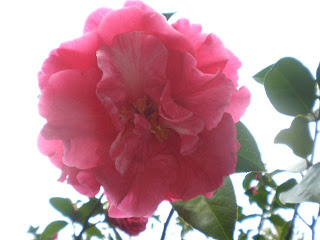



We had only two days left before Richard needed to return to Hong Kong for his flight to the US but the gorge was only about 3 hours from Li Jiang by bus. The gorge was cut by the Yangtze River and was the only remaining untamed part of this river. Known as the "Golden Sand" River here either because of the deposits of golden sand on the banks or the deposits of gold, it forms a canyon as deep as the Grand Canyon and much narrower across. Westerners have bee trekking there for 10 or 20 years and a road has been put through at about midlevel.
Since our time was very limited we decided to take a minivan from the park entrance to Tina's, a hotel on the road about half way through the park and hike down the gorge to the river. We arrived by noon, stowed our luggage in our room, ate some lunch and began our hike to the second rapids about 2000 feet and 2 hours walk below us. The river at 6000 feet above sea level runs between two 18,000 foot peaks though it is impossible to see the summits from the bottom of the gorge and one only gets glimpses of them from the road. There was a line of Chinese descending ahead of us but held up by one fearful and slow woman in the lead. We slowly made our way down to the bottom and everyone climbed on to the rock that the tiger leaped from to cross the gorge. Of course, the other side of the gorge was shear and vertical, so it wasn’t clear where the tiger leaped. Everyone took turns taking pictures of themselves on the tiger rock. It seems that Chinese tourists have mandatory photos at all the sites. The air was fresh, clean and clear. We were in the gorge next to the second. The trail up, ascended by a series of ladders over rock faces and again there were enough hikers that you had to wait for your turn on the ladder. We were however, the oldest people in the gorge, and two of only six westerners on that sunny wonderful afternoon. Judy decided that she couldn’t make it back to the top of the trail when a man with donkeys showed up and offered to take her up for a small fee.
The night was cold but our beds had heating pads so despite the wind rattling the windows and the lack of heat in the room we were toasty and warm. We decided to get up early and hike to the end of the normal trek which was about 40 minutes down the road to Sean’s Guest House where we had breakfast. The rest of the day consisted of making travel connections back to Li Jiang, visiting a little more of the village She Hu outside of Li Jiang before our flights to Szenzhen China arriving on the Hong Kong border only minutes before the midnight closing and then taking a train, bus and taxi back to our apartment in Hong Kong.
The next day, Monday, Richard went to the airport for his 15 hour flight to New York and the day after that Judy went back to Szenzhen for her flight to Jingdezhen.















































